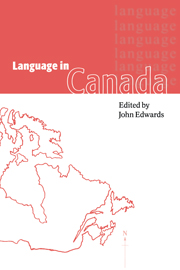Book contents
- Frontmatter
- Contents
- List of figures
- List of maps
- List of tables
- Notes on contributors
- 1 Canada
- Introduction
- 1 The foundations
- 2 The fading Canadian duality
- 3 Official bilingualism: from the 1960s to the 1990s
- 4 Official multiculturalism
- 5 Language in education: bridging educational policy and social psychological research
- 6 Aboriginal languages: history
- 7 Aboriginal languages: current status
- 8 French: Canadian varieties
- 9 French in Quebec
- 10 French in New Brunswick
- 11 French outside New Brunswick and Quebec
- 12 English: Canadian varieties
- 13 English Quebec
- 14 The teaching of international languages
- 15 French immersion in Canada
- 16 Language in Newfoundland
- 17 Language in Prince Edward Island
- 18 Language in Nova Scotia
- 19 Language in New Brunswick
- 20 Language in Quebec: aboriginal and heritage varieties
- 21 Language in Ontario
- 22 Language in Manitoba
- 23 Language in Saskatchewan: Anglo-hegemony maintained
- 24 Language in Alberta: unilingualism in practice
- 25 Language in British Columbia
- 26 Language in the Northwest Territories and the Yukon Territory
- Index of names
- Index of language families, languages, dialects
- Index of subjects
16 - Language in Newfoundland
Published online by Cambridge University Press: 18 February 2010
- Frontmatter
- Contents
- List of figures
- List of maps
- List of tables
- Notes on contributors
- 1 Canada
- Introduction
- 1 The foundations
- 2 The fading Canadian duality
- 3 Official bilingualism: from the 1960s to the 1990s
- 4 Official multiculturalism
- 5 Language in education: bridging educational policy and social psychological research
- 6 Aboriginal languages: history
- 7 Aboriginal languages: current status
- 8 French: Canadian varieties
- 9 French in Quebec
- 10 French in New Brunswick
- 11 French outside New Brunswick and Quebec
- 12 English: Canadian varieties
- 13 English Quebec
- 14 The teaching of international languages
- 15 French immersion in Canada
- 16 Language in Newfoundland
- 17 Language in Prince Edward Island
- 18 Language in Nova Scotia
- 19 Language in New Brunswick
- 20 Language in Quebec: aboriginal and heritage varieties
- 21 Language in Ontario
- 22 Language in Manitoba
- 23 Language in Saskatchewan: Anglo-hegemony maintained
- 24 Language in Alberta: unilingualism in practice
- 25 Language in British Columbia
- 26 Language in the Northwest Territories and the Yukon Territory
- Index of names
- Index of language families, languages, dialects
- Index of subjects
Summary
INTRODUCTION
In 1949 the island of Newfoundland, along with its continental portion, Labrador, became the tenth province of the Canadian confederation, of which it constitutes the largest of the four Atlantic provinces. From a linguistic perspective, present-day Newfoundland/Labrador is the most homogeneous area of the country. The overwhelming majority of Newfoundlanders – some 98 per cent, or 559,620 of a total population of 568,475 – claim English as their sole mother tongue (Statistics Canada, 1991). The number of aboriginal-language speakers in the province is very small; although languages representing both the Algonquian and Eskimo-Aleut families are still found in Labrador, these must today be classified as endangered. As to European languages, Newfoundland/Labrador has a rich linguistic history, since it was one of the earliest areas of the New World to be discovered: beginning in approximately AD 1,000, visitors to its shores have included speakers of Norse, Basque, Spanish, Portuguese, French, Irish Gaelic and Scots Gaelic. Most of these languages, however, have totally disappeared, leaving no trace of their passage other than toponymic evidence.
Twentieth-century immigration has played an important role in much of urban Canada, where it has created considerable linguistic diversity. In Newfoundland, however, where in-migration peaked in the first half of the nineteenth century, its effects have been minimal.
- Type
- Chapter
- Information
- Language in Canada , pp. 326 - 340Publisher: Cambridge University PressPrint publication year: 1998
- 1
- Cited by



